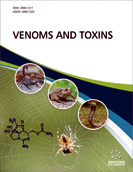- Home
- A-Z Publications
- Venoms and Toxins
- Issue Home
Venoms and Toxins - Current Issue
Volume 3, Issue 1, 2023
- Drug Design, Discovery and Therapy, Toxicology
-
-
-
Evaluation of the Toxicological Effects from Bothrops Jararacussu Snake Venom on Zebrafish (Danio Rerio) Embryos and Larvae
More LessIntroductionApproximately 90% of reported and identified cases of snakebites in Brazil are caused by species belonging to the Bothrops genus. These snakes have clinical relevance due to their venom composition, which contains substances capable of triggering local and systemic effects, leading to morbidities and/or mortality.ObjectiveThe objective of this study was to evaluate the toxic and toxinological effec Read More
-
-
-
-
Jellyfish Tissue Extract as Inhibition Effect of Jellyfish Olindias sambaquiensis Müller (1861) Sting
More LessBackgroundOlindias sambaquiensis, the most abundant species of jellyfish along the southern coast of Brazil, frequently stings bathers during the summer months, when the occurrence of this species usually reaches a peak.ObjectiveAs jellyfish are rich in protein and carbohydrates, and as these biomolecules could provide a natural defense against stings, this study investigates whether any of the components present in the Read More
-
-
-
In-vitro and In-vivo Neutralization Activity of Methanol Extract of Adansonia digitata Fruit Pulp against Naja nigricollis Venom
More LessBackgroundAdansonia digitata has been used as a traditional medicine to treat various diseases including snakebite envenomation.ObjectiveIn this study, the protective and ameliorative potentials of crude methanol extract of Adansonia digitata fruit pulp against crude venom of Naja nigricollis in-vitro and in-vivo were investigated.MethodsThe dose-dependent inhibitory studies, pharmacological, histopathological and in vivo stud Read More
-
-
-
Substances of Milky Juice of Genus Lactarius Fungi: Chemical and Toxicological Characteristics
More LessBackgroundFungi of the genus Lactarius Pers. before the maturation of spores are not damaged by microorganisms, insects, mollusks, and animals. Such resistance correlates with the period when the basidiomes of these fungi are filled with milky juice, which contains substances of various chemical nature that provide their protection.ObjectiveThe aim of our work is to present the results of our recent and previously Read More
-
Volumes & issues
Most Read This Month Most Read RSS feed
Article
content/journals/vat
Journal
10
5
false
en


